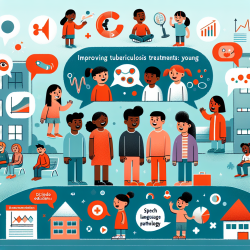Introduction
The recent research article titled "Strengthening Tuberculosis Services for Children and Adolescents in Low Endemic Settings" provides valuable insights for healthcare practitioners looking to enhance their skills and improve outcomes for children. The study highlights the importance of active case-finding through contact tracing and the need for high-quality laboratory services, emphasizing the necessity of continued education for medical providers.
Key Findings
In low tuberculosis (TB) burden countries, children and adolescents with the highest incidence of TB infection or disease are usually those who have immigrated from high-burden countries. This underscores the need for healthcare services to focus on immigrant and refugee families to ensure proper testing, evaluation, and treatment for TB. The research points out that active case-finding through contact tracing is critical for early detection and treatment, while passive case-finding often results in delayed diagnosis.
Implementing Research Outcomes
Practitioners can enhance their skills by implementing the following strategies based on the research findings:
- Active Case-Finding: Engage in thorough contact tracing to identify and treat TB cases early, particularly in high-risk groups such as immigrants and refugees.
- Utilize Laboratory Services: Make full use of available laboratory services for the detection of Mycobacterium tuberculosis to avoid delays in diagnosis.
- Education and Awareness: Participate in ongoing education and collaborate with educational and non-governmental organizations to maintain awareness and knowledge about TB.
Encouraging Further Research
While the research provides a solid foundation, it also highlights areas that require further investigation. Practitioners are encouraged to explore the following areas:
- Investigate the effectiveness of different TB prevention strategies in low-burden settings.
- Study the impact of cultural and socioeconomic factors on TB diagnosis and treatment adherence.
- Examine the role of new technologies in improving TB detection and treatment outcomes.
Conclusion
Strengthening TB services for children and adolescents in low endemic settings is crucial for achieving better health outcomes. By implementing the research findings and encouraging further study, practitioners can play a pivotal role in enhancing TB care and prevention. To read the original research paper, please follow this link: Strengthening Tuberculosis Services for Children and Adolescents in Low Endemic Settings.










